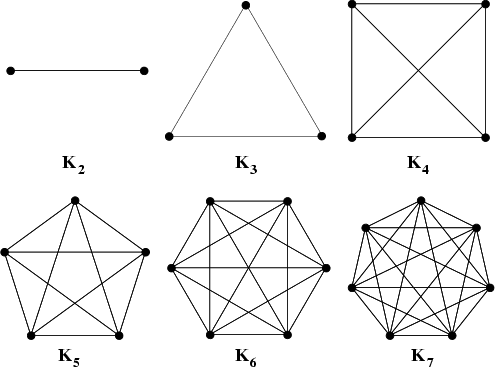|
|
|

A Graph in which each pair of Vertices is connected by an
Edge. The complete graph with ![]() Vertices is denoted
Vertices is denoted ![]() . In older
literature, complete Graphs are called Universal Graphs.
. In older
literature, complete Graphs are called Universal Graphs.
![]() is the Tetrahedral Graph and is therefore a Planar Graph.
is the Tetrahedral Graph and is therefore a Planar Graph. ![]() is nonplanar. Conway and Gordon (1983)
proved that every embedding of
is nonplanar. Conway and Gordon (1983)
proved that every embedding of ![]() is Intrinsically Linked with at least one pair of linked triangles. They also
showed that any embedding of
is Intrinsically Linked with at least one pair of linked triangles. They also
showed that any embedding of ![]() contains a knotted Hamiltonian Cycle.
contains a knotted Hamiltonian Cycle.
The number of Edges in ![]() is
is ![]() , and the Genus is
, and the Genus is
![]() for
for ![]() . The number of distinct variations for
. The number of distinct variations for ![]() (Graphs which
cannot be transformed into each other without passing nodes through an Edge or another node)
for
(Graphs which
cannot be transformed into each other without passing nodes through an Edge or another node)
for ![]() , 2, ... are 1, 1, 1, 1, 1, 1, 6, 3, 411, 37, .... The Adjacency Matrix of the complete graph takes
the particularly simple form of all 1s with 0s on the diagonal.
, 2, ... are 1, 1, 1, 1, 1, 1, 6, 3, 411, 37, .... The Adjacency Matrix of the complete graph takes
the particularly simple form of all 1s with 0s on the diagonal.
It is not known in general if a set of Trees with 1, 2, ..., ![]() Edges can always
be packed into
Edges can always
be packed into ![]() . However, if the choice of Trees is restricted to either the path or star from each
family, then the packing can always be done (Zaks and Liu 1977, Honsberger 1985).
. However, if the choice of Trees is restricted to either the path or star from each
family, then the packing can always be done (Zaks and Liu 1977, Honsberger 1985).
References
Chartrand, G. Introductory Graph Theory. New York: Dover, pp. 29-30, 1985.
Conway, J. H. and Gordon, C. M. ``Knots and Links in Spatial Graphs.'' J. Graph Th. 7, 445-453, 1983.
Honsberger, R. Mathematical Gems III. Washington, DC: Math. Assoc. Amer., pp. 60-63, 1985.
Saaty, T. L. and Kainen, P. C. The Four-Color Problem: Assaults and Conquest. New York: Dover, p. 12, 1986.
Zaks, S. and Liu, C. L. ``Decomposition of Graphs into Trees.'' Proc. Eighth Southeastern Conference on
Combinatorics, Graph Theory, and Computing. pp. 643-654, 1977.
|
|
|
© 1996-9 Eric W. Weisstein